Taking an environmentally sensitive approach to pest management
Espalier: Pruning as an Art Form
Published: June 15, 2021
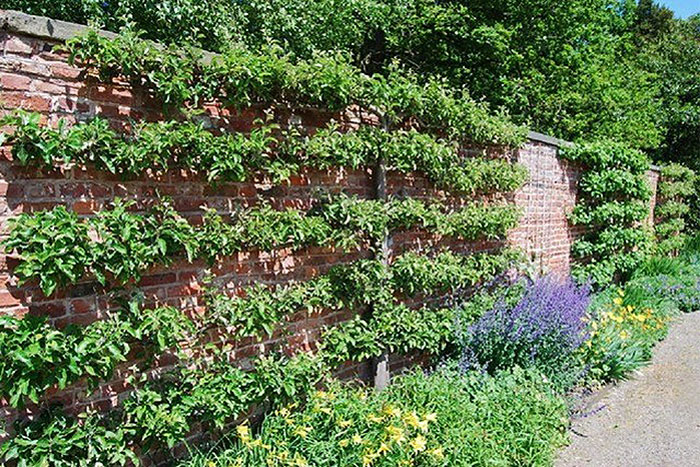
Credit: https://writesofnature.com
The word espalier (pronounced "es-PAL-yer" or "es-pal-YAY") is French and was derived from the Italian spalliera. Literally interpreted, the latter means "something to rest the shoulder against." Centuries ago, espalier referred to the structure to which plants were trained. Over time, the word has evolved to refer to the practice of training plants to a flat plane such as a wall, fence or trellis, or to the plants themselves.
Ancient Romans are credited with first practicing this type of pruning. Later, during the Middle Ages, it was refined into what can best be described as an artform. Originally, the primary reason for using this pruning technique was for increased production within limited space. In medieval times, the practice was popular in Europe as a means of producing fruit against the inside walls of castles without occupying valuable open space. In fact, to some the word espalier is synonymous with the term "fruit wall", a production method that originated in the16th century which took advantage of radiant energy stored in walls during the day to raise the night temperature around attached plants.
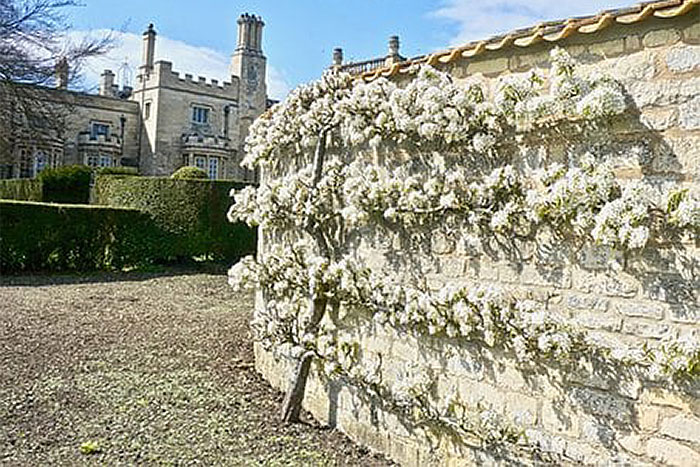
Fruit wall
An espalier is a living sculpture in the garden. Even though home gardeners usually are faced with doing their own pruning, this time-consuming technique still is popular among those who want something unique, or have a location where an unusual accent is desired. It can be an attractive way to add beauty to a large blank wall or fence where there is insufficient room for spreading shrubs or trees. With the addition of accent lighting, the results from creating an espalier can be dramatic.
While the original espaliers were made only from fruit trees, today many ornamental plants can be pruned into beautiful displays. Espaliers, however, are not low maintenance gardening. Most must be pruned at least twice yearly: once during the dormant period, and at least once during the growing season. Any watersprouts (i.e., excessively vigorous shoots) must be removed or trimmed back severely whenever they develop. Frequent tying to develop the shape of the espalier also is required, particularly in its early years.
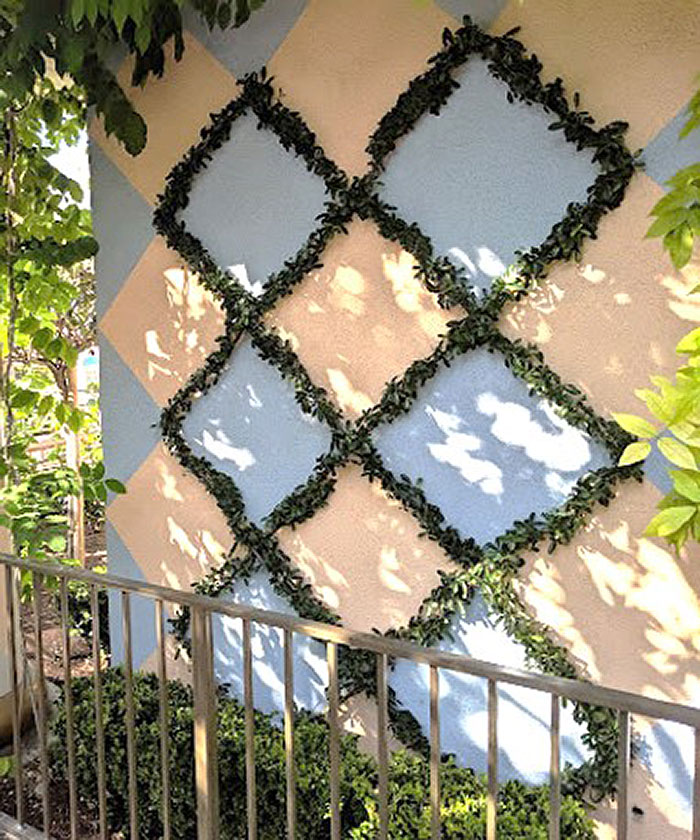
Credit: Jake Parrillo
There are numerous patterns into which espaliers can be pruned. Most impressive are the neatly clipped geometric forms. These might take the form of squares, diamonds or rectangles. For example, a well-maintained "Belgian lattice" espalier looks especially exquisite with its series of inter-connected diamond shapes. Candelabra shapes, fan shapes or S-shapes may also provide a dramatic accent and are a bit easier to develop and maintain. The simplicity or complexity of the espalier's shape depends largely on the time, talent and interest of the gardener.
Since shoots must be attached regularly to maintain the design, the trellis or frame for the espalier is extremely important. If a wall is used to support the espalier is of masonry construction, a trellis may be formed by drilling a few holes into the wall and inserting anchor bolts of some type. Several of these anchors can be connected with coated wire that does not rust in order to form the desired shape or pattern. If drilling is not possible, a framework of pipe or wood can be constructed for support and located about six inches from the wall. If wood is used, make sure it naturally resists decay (e.g., cypress) or is pressure treated with a wood preservative (e.g., ACQ).
The training technique used largely will depend on the pattern selected and the number of laterals on the plant. When following a specific design, carefully bend the branches into the desired positions and tie them into place on the support. Tie shoots loosely to avoid girdling as the branches increase in diameter. Wire ties tightly attached to the branches can damage the branches if left on too long. Stretch tie-tape designed for garden use is an ideal alternative to wire, since it expands as the shoots increase in diameter. Shoots which cannot be attached to the support should be pruned from the plant.
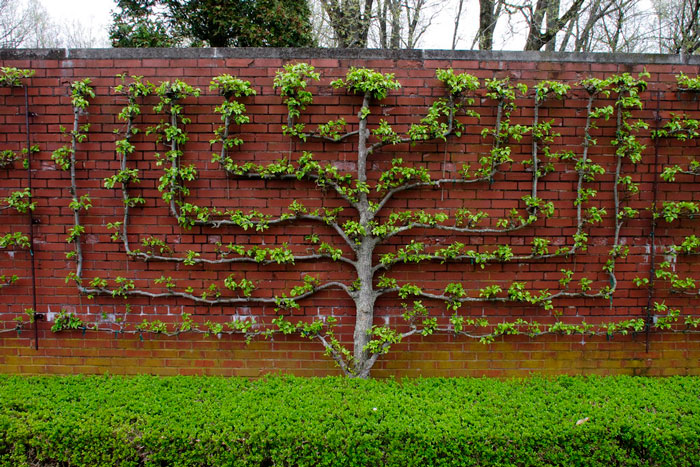
Credit: J. P. Matth
Some of the easiest plants to espalier are those with flexible branches that can be shaped even after they get a bit older. Examples of such species include forsythia, pyracantha and cotoneaster. One of the best evergreen plants for an espalier is yew (Taxus); cultivars having an upright growth habit (e.g., 'Hicksii') are particularly useful. Additional candidates to espalier include Japanese maple, Japanese flowering quince, redbud, dogwood, flowering cherry and doublefile viburnum.
Apples and pears are among the easier fruit trees for espaliers because many cultivars are available on dwarfing or semi-dwarfing rootstocks. The latter tend to be productive without growing overly fast. Flowering crabapples also are good subjects for espaliers. When trees are selected for this purpose, they should be pruned back severely, but not below the graft union. As young shoots emerge, they must promptly be tied to the espalier support as they develop. Once woody branches become older, they cannot be bent sharply and risk being injured or broken during the training process.
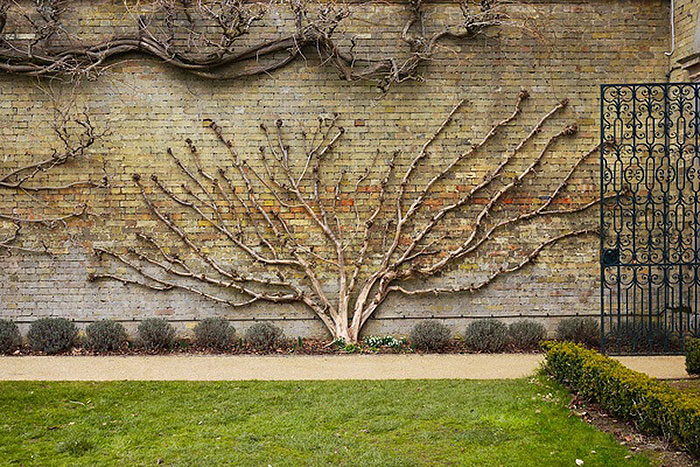
Decades old espalier
The species of plant selected to espalier largely is a matter of personal taste and overall landscape design. The amount of time available to maintain the espalier also should be considered when selecting a species. Whatever the species selected, approach the project with patience. It normally takes at least five years for an espalier to grow into an attractive work of art. Properly done, however, an attractive espalier is well worth the wait.
Subscribe to receive similar articles sent directly to your inbox!
- Espalier: Pruning as an Art Form (06/15/21)
- Salvaging Trees after Heavy Snowfall (01/28/19)
- Cleaning and Disinfecting Pruning Tools for Orchard Crops (01/26/18)
REVISED: June 15, 2021